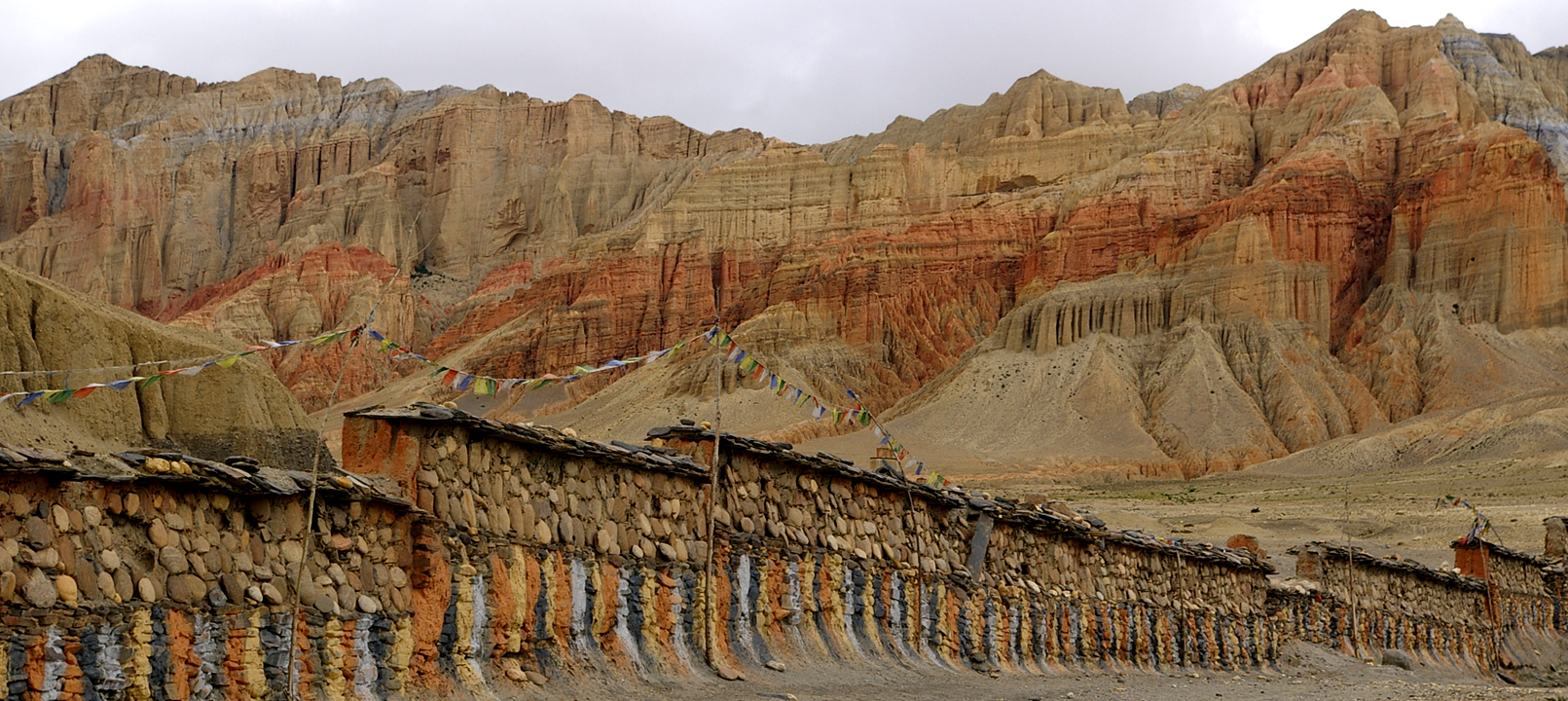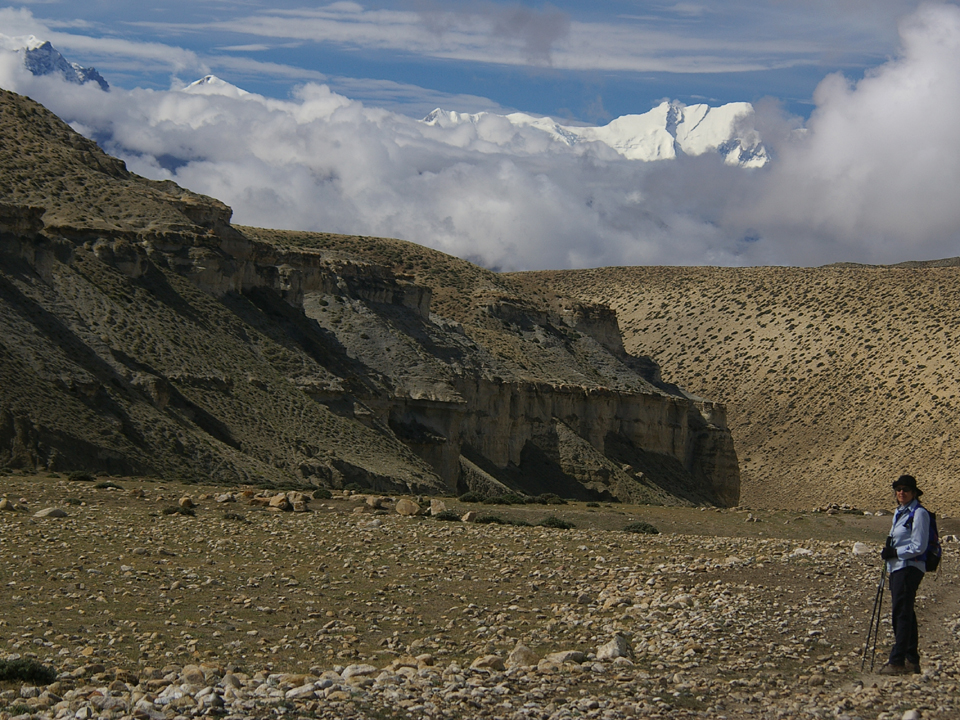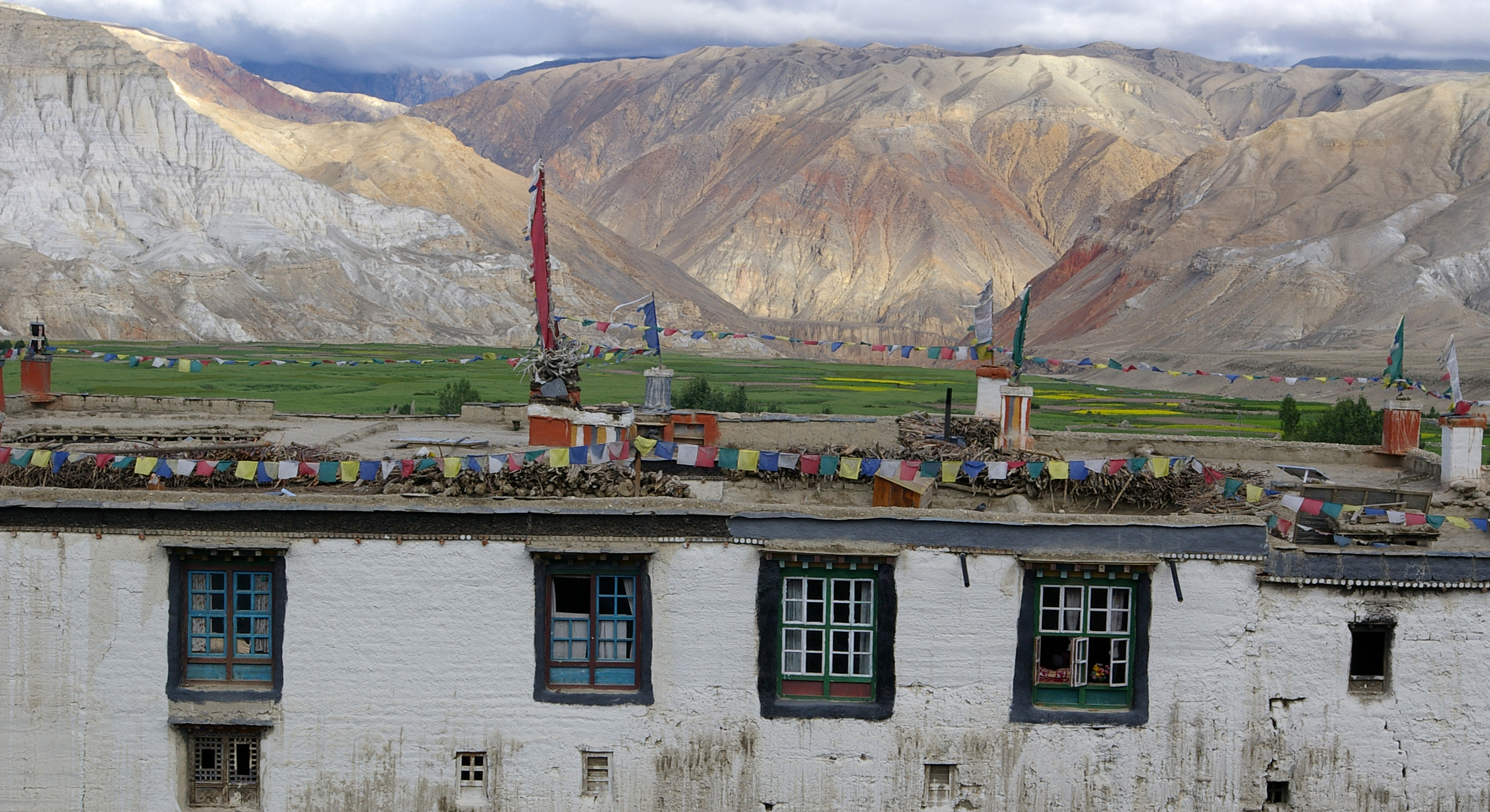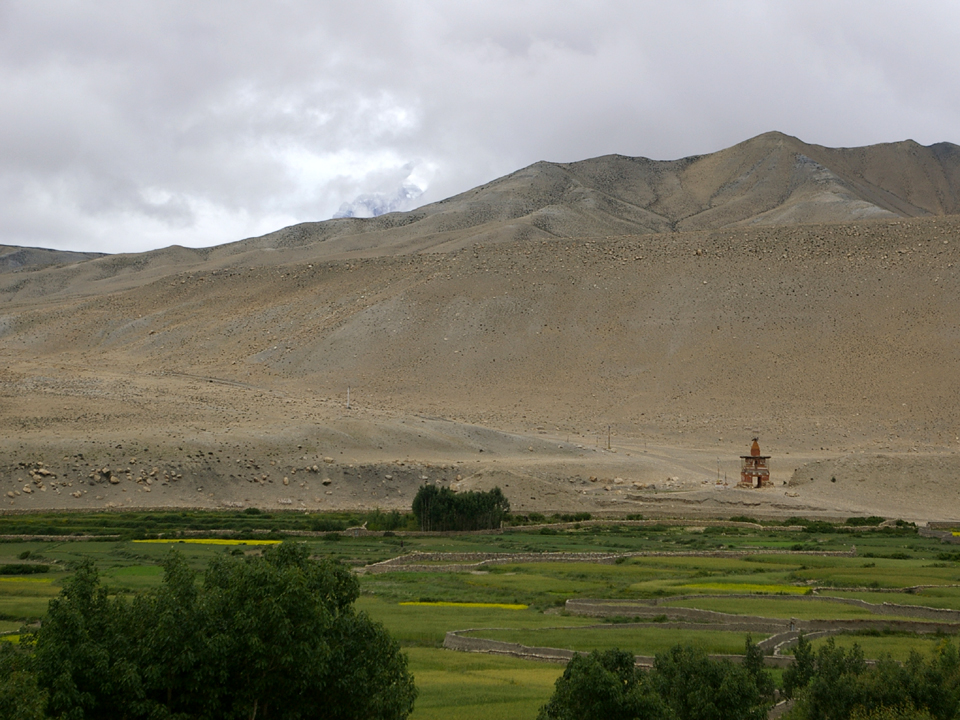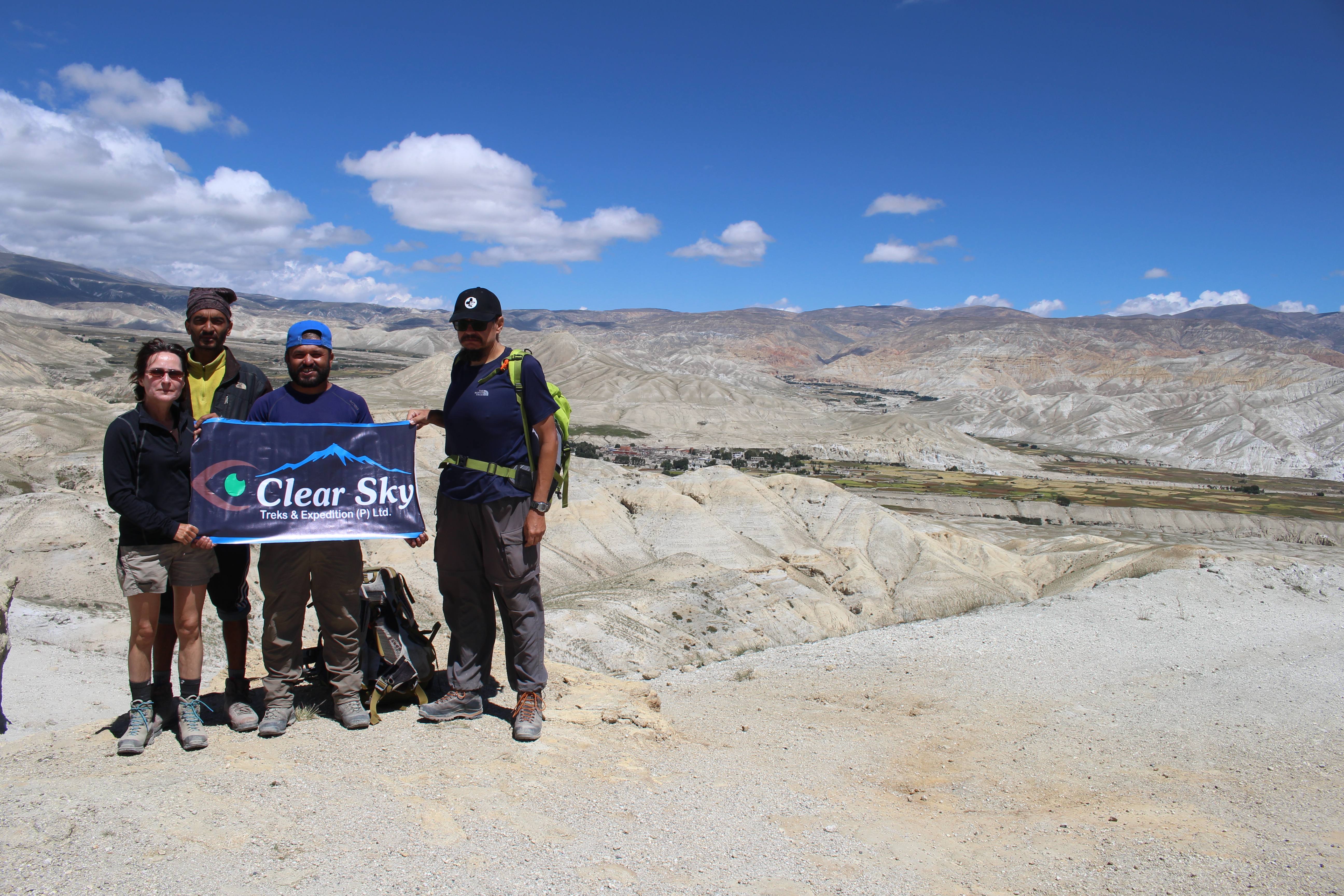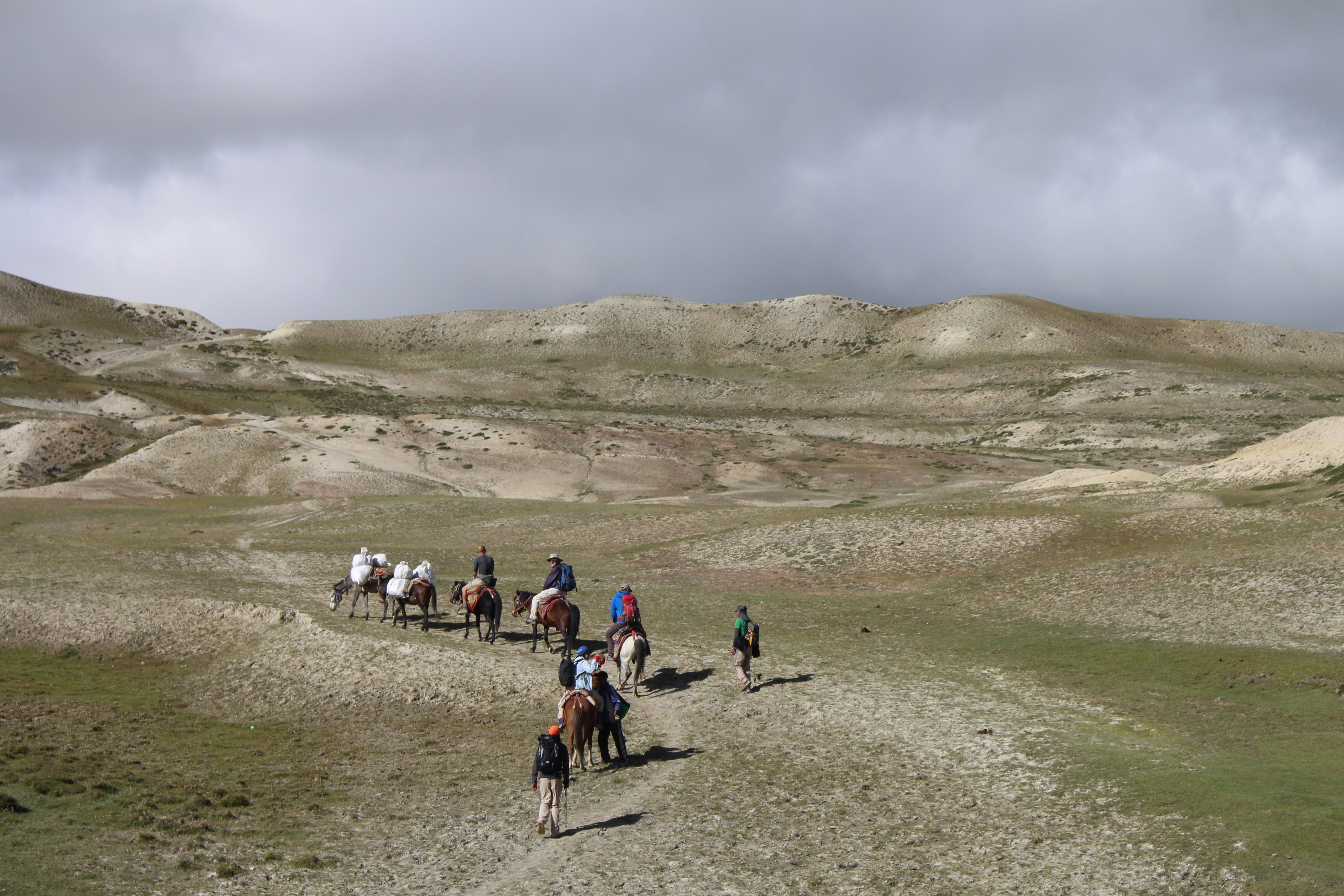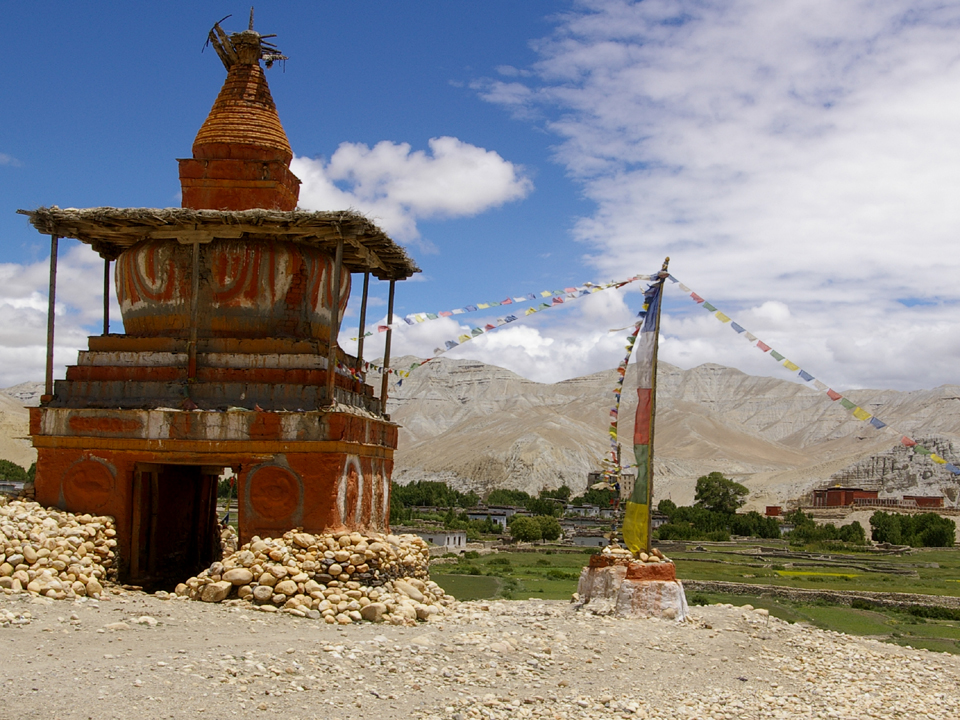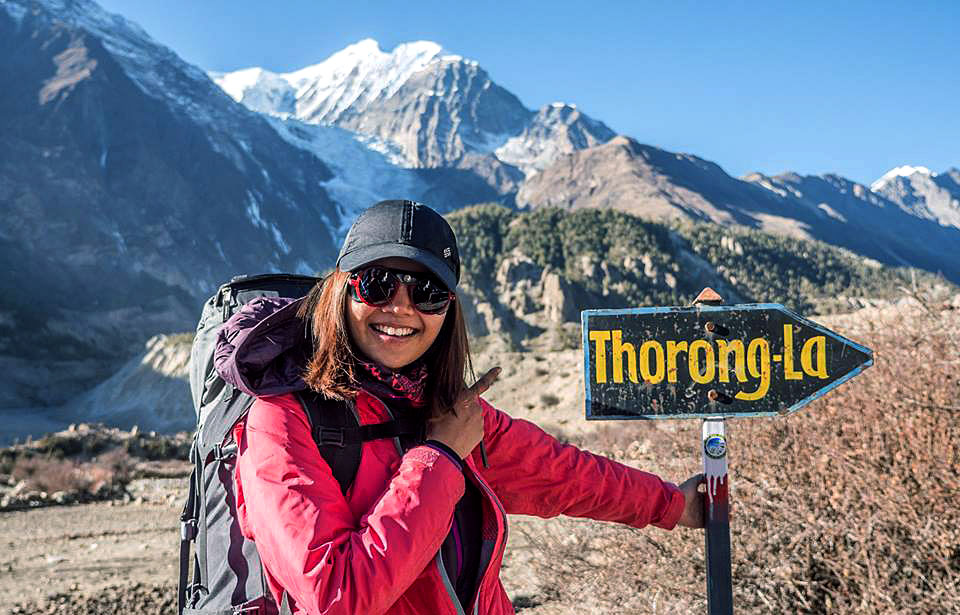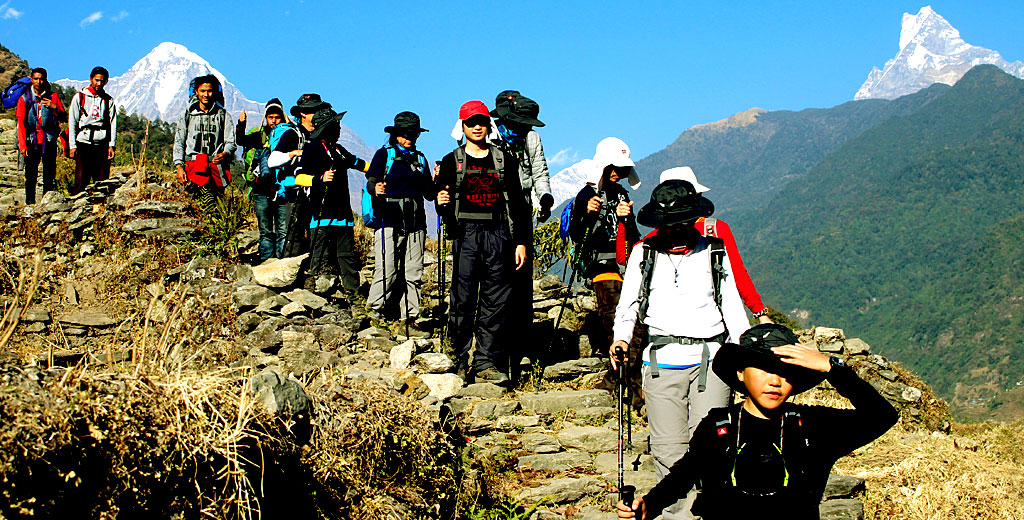Highlights
Upper Mustang Trek allows only limited trekkers in a year. This is to preserve the tradition and delicate environment. Bordered with the Tibet, the culture, lifestyle, geography and religion is mostly influenced by Tibet. Buddhism being the main religion, you will see ancient monasteries during your visit to Upper Mustang. Colorful prayer flags, prayer wheels, mani, chortens, and wall paintings can be seen during your trek.Being isolated from the outside world, Upper Mustang has very well preserved its monuments like the century old monasteries, the sculptures, and the caves. The major attraction here is Lo Manthang, where there a well preserved ancient palace and monasteries like Thugchen Gompa. During your visit here, you can also roam around the area caves that are dwelled in the walls.If you reach Upper Mustang during May and June, you will be able to witness the famous Tiji festival in Lo Manthang. This is one of the auspicious festivals here in this region. It is celebrated to mark the victory if good over evil. People from different part of Mustang gather here to participate in this festival. Monks performs different dance and rituals during Tiji.
One way to reach Upper Mustang is to fly to Pokhara and then fly to Jomsom. This will save you some time to explore around Mustang. The flight itself is an adventurous flight, because it will take you to the deepest gorge of Kali Gandaki river between Mt. Nilgiri and Mt. Dhaulagiri. If you have some extra time to spare, you can choose to drive from Pokhara to Jomsom, enjoying the beauty of the nature. This off road drive you take you to different villages like Beni, Tatopani, Ghasa, and to Jomsom, which is a part of Lower Mustang. From there you can drive or trek to reach Kagbeni. it is worth to take a route to visit Muktinath itself. This will help you to acclimatize proper before heading to Kingdom of Lo Manthang. The trail follows through the bank of Kali Gandaki river. Trail passes through villages like Chele, Ghami, Tsarang, and then to Lo Manthang. As it is a rain shed area, it is best to travel here during monsoon season. The deserted yet beautiful landscape with the mountains in the surrounding will be one of the major attractions here. Besides these, house architecture, villages, apple orchard, centuries old monasteries will accompany you throughout the trek. Depending upon the weather condition you will have to walk for about 8 hours a day, but in an average you will walk for about 5-6 hours a day. The highest altitude you will gain is in Lo Manthang which is about 3800 m high from sea level.
As it is a restricted area, you will have to make a group of at least two trekkers and hire a guide. You also have to get a special permit to enter this region. Permit will cost you around $500 for 10 days and extra $50 for each additional days. Our company will arrange these necessary documents.You will be staying in guesthouse during your trek here. This will help to get close to the local resident here which will help to know more about the lifestyle and culture.Buddhism being the main religion, you will see ancient monasteries during your visit to Upper Mustang. Colorful prayer flags, prayer wheels, mani, chortens, and wall paintings can be seen during your trek.
Being isolated from the outside world, Upper Mustang has very well preserved its monuments like the century old monasteries, the sculptures, and the caves. The major attraction here is Lo Manthang, where there a well preserved ancient palace and monasteries like Thugchen Gompa. During your visit here, you can also roam around the area caves that are dwelled in the walls.If you reach Upper Mustang during May and June, you will be able to witness the famous Tiji festival in Lo Manthang. This is one of the auspicious festivals here in this region. It is celebrated to mark the victory if good over evil. People from different part of Mustang gather here to participate in this festival. Monks performs different dance and rituals during Tiji.
One way to reach Upper Mustang is to fly to Pokhara and then fly to Jomsom. This will save you some time to explore around Mustang. The flight itself is an adventurous flight, because it will take you to the deepest gorge of Kali Gandaki river between Mt. Nilgiri and Mt. Dhaulagiri. If you have some extra time to spare, you can choose to drive from Pokhara to Jomsom, enjoying the beauty of the nature. This off road drive you take you to different villages like Beni, Tatopani, Ghasa, and to Jomsom, which is a part of Lower Mustang. From there you can drive or trek to reach Kagbeni. it is worth to take a route to visit Muktinath itself. This will help you to acclimatize proper before heading to Kingdom of Lo Manthang. The trail follows through the bank of Kali Gandaki river. Trail passes through villages like Chele, Ghami, Tsarang, and then to Lo Manthang. As it is a rain shed area, it is best to travel here during monsoon season. The deserted yet beautiful landscape with the mountains in the surrounding will be one of the major attractions here. Besides these, house architecture, villages, apple orchard, centuries old monasteries will accompany you throughout the trek. Depending upon the weather condition you will have to walk for about 8 hours a day, but in an average you will walk for about 5-6 hours a day. The highest altitude you will gain is in Lo Manthang which is about 3800 m high from sea level.
As it is a restricted area, you will have to make a group of at least two trekkers and hire a guide. You also have to get a special permit to enter this region. Permit will cost you around $500 for 10 days and extra $50 for each additional days. Our company will arrange these necessary documents.
You will be staying in guesthouse during your trek here. This will help to get close to the local resident here which will help to know more about the lifestyle and culture.
Itenary
Duration: 15 Nights / 16 Days
Max Altitude: 3840 m
Difficulty: Moderate
Cost: USD 1550 Per Person
Country: Nepal
Activity: Explore Nepal, Tour, Trekking
Starting Point: Kathmandu
Ending Point: Kathmandu
-
Day 1: Arrive at Kathmandu 1350 m. Transfer to Hotel.
Welcome to Kathmandu, the capital city of the Himalayan kingdom of Nepal.You will be met on airport and transferred to your hotel. After the arrival, the group will be formally introduced to Guide for the activities over the next few days. One should pay attention in particular to the safety aspects of the briefing. Any questions or doubts should be asked and clarified at this time. We check your insurance details and other requirement for your trekking.
-
Day 2: Sight seeing around at Kathmandu
After breakfast, we start an interesting tour around Kathmandu. Escorting by an English speaking guide be, try to give them a full taste of our vivid culture image and an enchanting manner of its people. In our sightseeing tour we go to Monkey temple Swayambhunath, Pashupatinath and Kathmandu Durbar square. Durbar Square: -This complex of palaces, courtyards and temples, built between the 12th and 18th centuries, used to be the seat of the ancient Malla kings of Kathmandu. An intriguing piece here is the 17th century stone inscription set into the wall of the palace with writings in 15 languages. The Durbar square, protected as an UNESCO world Heritage site, is the social, religious and urban focal point of the city. There are also museums inside the palace building. There is an entrance fee of Rs.250 for foreign visitors. Your ticket to the Square entitles you to visit all the museums. Swayambhunath, 6.5 kilometers west of Kathmandu, situated on a hillock, this 2000 years old Stupa is the world’s most glorious Buddhist shrine and is surrounded by several small pagodas. The main temple is capped by a pinnacle of copper gilt and is painted on the four sides with all seeing eyes of Lord Buddha. Pashupatinath, dedicated to Lord Shiva, is the holiest and most famous Nepalese temple. Situated 5 kilometers northeast of Kathmandu on the bank of the sacred Bagmati River, it is an impressive pagoda style structure with gilt roof and richly carved silver doors. It has bathing and cremation ghats, which are of absorbing interest to the tourist, particularly in the mornings and on festival days.
-
Day 03: Kathmandu - Pokhara drive (960 m / 6hrs)
Drive or Fly to Pokhara. Pokhara is a big natural Beauty City out of Kathmandu, which is 200km from Kathmandu. Pokhara is a place of remarkable natural beauty. The serenity of Phewa Lake and the magnificence of fishtailed Machhapuchhre rising behind it make it an ideal setting to spend a few days in Pokhara.
-
Day 04: Pokhara - Jomsom fly (2700 m). Trek to Kagbeni (2800 m / 4hrs)
Fly out from Pokhara with beautiful locations between Annapurna and Dhaulagiri, between them there is the deepest gorge of the world and come out flat, wide rain shed valley appearing Tukuche, Marpha and Jomsom itself the land left hand side of Kaligandaki river which is one of the biggest river in Nepal.Mostly it will be windy during the afternoon so the morning flight is taken to get there. After that the way along the Kaligandaki river with sandy riverbed refers to the Kagbeni. On the way, sometimes you will get an opportunity to see the pilgrimages of Hindus from Nepal and India. Walking through to Kagbeni we will be able to visit the place called Eklabhhati (the place where we can find tea shops). Here we can stop to have hot tea with the panoramic view of Kagbeni and further up the valley. After walking 3 hours we will reach Kagbeni, a fascinating medieval rabbit-warren of crumbling mud-brick houses, standing in a little green oasis dominated by it’s red Gompa. The ruins of the old fort bear, in the center, witness to the fact that this was once an important place, strategically placed at the junction of two valleys. At the evening, Kagbeni monastery is visited with big red wall having the prey’s flags and with Khatas, a yellow scarf. This Monastery under Nyingmapa is mostly similar to a lot of in Mustang. This Gompa is decorated with different kind of paints than other monasteries are, round the areas.
-
Day 05: Kagbeni – Chele (3100 m / 6hrs)
There is a trail up the east bank of the Kali Gandaki that climbs over many ridges as it heads north and reaches Tangbe village. The town is a labyrinth of narrow alleys amongst whitewashed houses, fields of buckwheat, barley, wheat and apple orchards. Nilgiri peak, which dominates the southern skyline at Kagbeni, continues to loom massively at the foot of the valley. Beyond Tangbe, we reach Chhusang village and crossing the river, continue climbing north up the trail to a huge red chunk of conglomerate that has fallen from the cliff above, forming a tunnel through which the Kali Gandaki flows. The trek now leaves the Kali Gandaki valley and climbs steeply up a rocky gully to Chele at 3030m. The culture changes from the Manangi culture to the Tibetan culture of Lo.
-
Day 06: Chele – Geling (3570m / 8hrs)
The climb continues along steep, treeless, waterless terrain, along the side of a spectacular steep canyon to a pass and cairn of rock at 3540m. Then the trail makes a long gradual descent to some chortens on a ridge, before descending further on a pleasant trail to Samar. The Annapurna, still dominated by Nilgiri, is visible far to the south. The route climbs sharply up and down over a series of high passes, before the final descent to Geling.
-
Day 07: Geling – Charang (3560 m / 7hrs)
From Geling, the trail climbs gently to the most interesting pass on your trek, Nyi La and descends beneath blue, grey and red cliffs across the valley to a bridge over the Tangmar Chu (river,) then climbs past what is perhaps the longest and most spectacular mani (prayer wall) in Nepal. Climbing over another pass at 3600m, the route makes a long gentle descent to Charang. The huge five–story white Dzong (fort) and red gompa (Buddhist temple) contains a fascinating array of statues and Thankas as well as many large paintings of seated Buddhas.
-
Day 08: Charang - Lo Manthang (3840 m / 5hrs)
The trail descends about 100 m from Charang, crosses the Charang–Chu, climbs steeply up a rocky trail to a cairn on a ridge and continues to climb. Finally from a ridge at 3850m, there is a view of the walled city of Lo. After a short descent, cross a stream then climb up into the plateau of Lo Manthang.
-
Day 09: Lo Manthang rest
Another day in Lo Manthang gives you the chance to explore its many sights; the Tall Champa Lakhang (God house,) the red Thugchen Gompa, Chyodi Gompa and the Raja’s Palace; as well as to gaze at the surrounding panoramic views of the Tibetan Plateau and the Himalaya. Besides Lo Manthang there is two other interesting valleys worth visiting. The western valley Tingkhar, the sight of Raja’s summer palace, Kimling and Phuwa as well as the Gompa of Namgyal (The Monastery of Victory) is the newest and most active Gompa in Lo. In the eastern valley lies the village of Chosar, also rich in gompas and the valley is the main trading route to Lhasa.
-
Day 10: Lo Manthang - Ghami (3520 m / 6hrs)
This is an opportunity to visit two other villages on your return trek. The trail climbs steadily to the pass marked by a cairn, offering a last glimpse of Lo Manthang. Crossing a ridge at 4070m, the trail then bumpily to Gekar. Lo Gekar Gompa is one of the oldest gompas in Nepal. And is older than the famed Samye Gompa in Tibet. Passing through Thamar village, the steep trail finally reaches Ghami.
-
Day 11: Ghami – Samar (3540 m / 6hrs)
From Ghami climb to Nyi La and descend to Samar through the same route.
-
Day 12: Samar - Kagbeni (2800 m / 5hrs)
Return trek to Kagbeni.
-
Day 13: Kagbeni – Jomsom (2700 m / 4hrs)
Return trek to Jomsom.
-
Day 14: Jomsom - Pokhara fly (960m / ½ hr)
After breakfast walking to airport to fly towards Pokhara.
-
Day 15: Pokhara – Kathmandu drive (1300 m / 6hrs)
After breakfast in the morning we say goodbye to Pokhara and head back to bustling Kathmandu by car or private bus (There is an option to fly). In the afternoon free day of your own. Overnight in Hotel.
In the evening we will drive you for farewell dinner with cultural dance.
-
Day 16: Final Departure.
All too soon it’s time to bid Nepal farewell and one realizes that we can never be intimate, only acquainted with this amazing adventure kingdom.
Tour Accomodation
What's Included
- Arrival/Departure
As per itinerary.
- Accomodation
Twin sharing accommodation in 2 star to 4 star hotel in Kathmandu & Pokhara with b'fast as per itinerary.
- Transportation
Pokhara/Jomsom/Pokhara flight ticket for member and Nepali crew local bus/private jeep or flight.
- Permits
All necessary permits during sightseeing and trekking.
- Meals
All 3 meals and accommodation while on the trek. (camping or Tea house)
- Guides/Porter
Fully escorted trek with English speaking guide, experienced cook, Sherpa and 1 porter between 2 members.
- Equipments
Tents, mattress, sleeping bag, cooking utensils and other camping equipment.
- Others
Wages, equipment, insurance and other facilities to staffs.
- Staff Insurance
Trekking Staffs insurance by our company
- Farewell Dinner
IN Nepal Traditional Restaurant
- Certificate
Trip Success Certificate
- Airfare
International Airfare.
- Visa Fees
Nepal Visa fee (US$ 40 per person).
- Taxes/Charges
Airport Departure taxes/Excess baggage charges.
- Permits
Special restricted permit First 10 days US$ 500 per person. After first 10 days US$ 50 per day per person.
- Meals
Lunch/Dinner in Kathmandu and Pokhara.
- Insurance.
Travel Insurance.
- Medical emergencies
Medical evacuation in case of emergency.
- Personal Expenses
Personal spending money. Items of personal nature i.e. Soft/hard drinks, Tips etc. Expenses incurred due to mishaps, landslide, strikes, political unrest etc. In such case extra will be charged as per actual.
- Tip
Tip for staffs
Availability
| Start | End | Status | Price | |
| January 15, 2020 | June 30, 2020 | Available | USD 1550 per person | Book Now |

